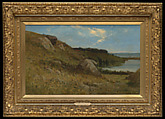Newport
Edward Bannister American
Bannister, born in New Brunswick, Canada, of West Indian and Canadian parentage, studied art at the Boston Museum School and the Rhode Island School of Design, in Providence, where he began his professional career as a landscape painter. He became an active member of that city’s art scene, as both a teacher and co-founder of the Providence Art Club. Famously, he was the first known Black artist to win a prize in the U.S.—for his pastoral landscape Under the Oaks (unlocated) at the Centennial International Exhibition, America’s first world’s fair, held in Philadelphia, in 1876. When his race was discovered, the jurors tried to rescind the award, but his fellow exhibition artists protested, and he was given the bronze medal. As one of the first painters of color with a national reputation, Bannister achieved success for his Barbizon-inspired works as well as for his more dynamic coastal scenes, such as this view of Newport, Rhode Island.
Due to rights restrictions, this image cannot be enlarged, viewed at full screen, or downloaded.
This artwork is meant to be viewed from right to left. Scroll left to view more.




